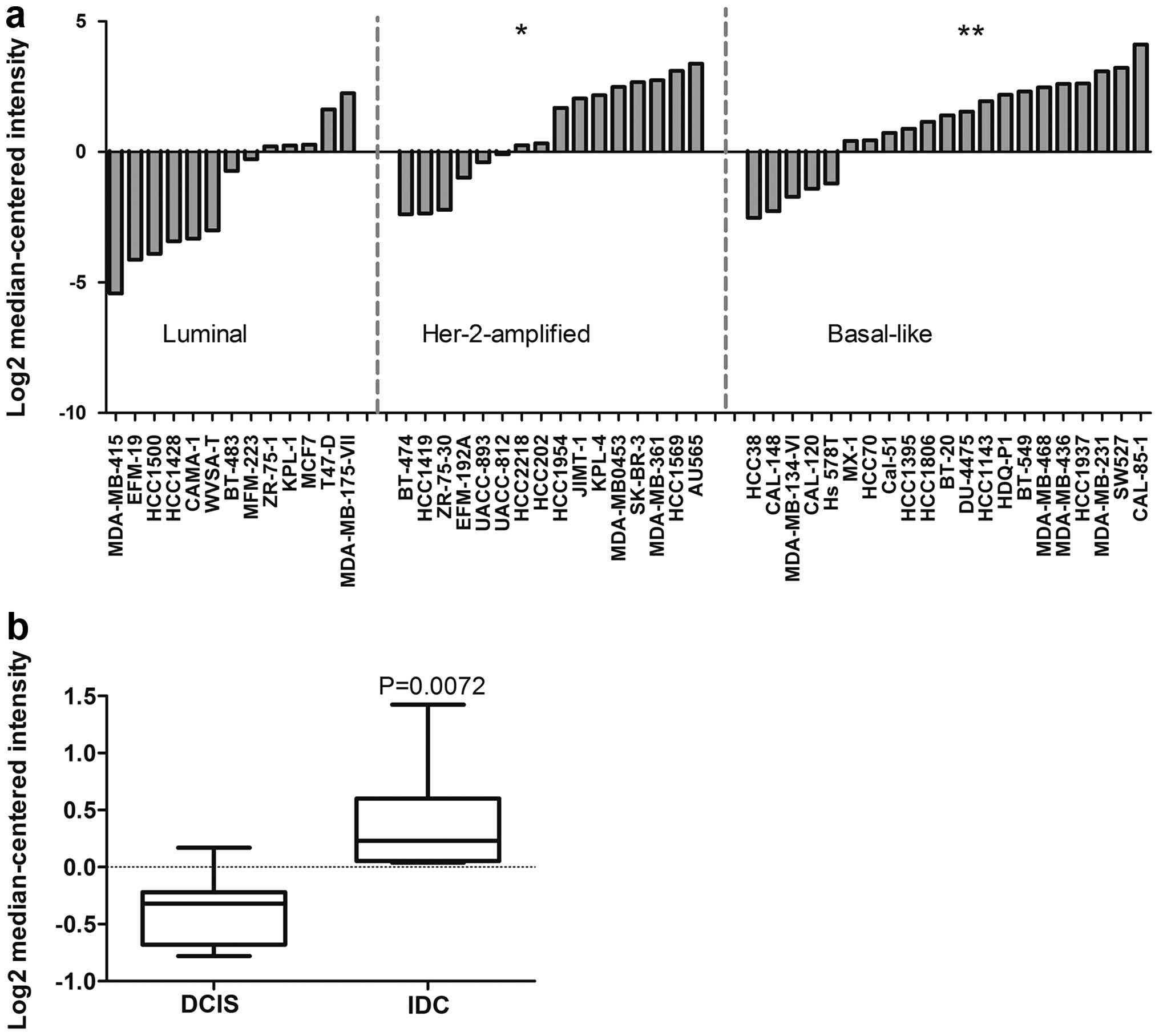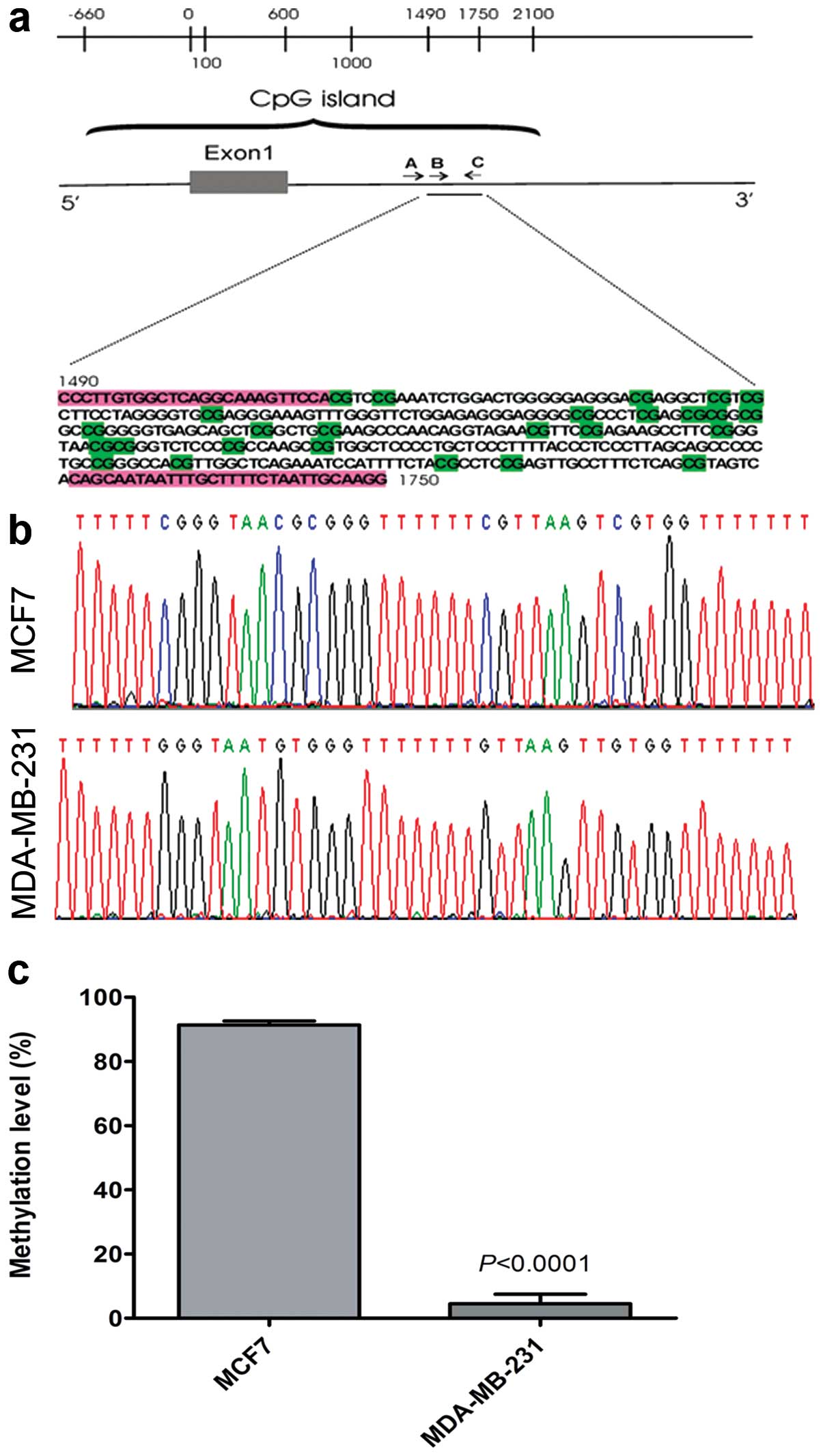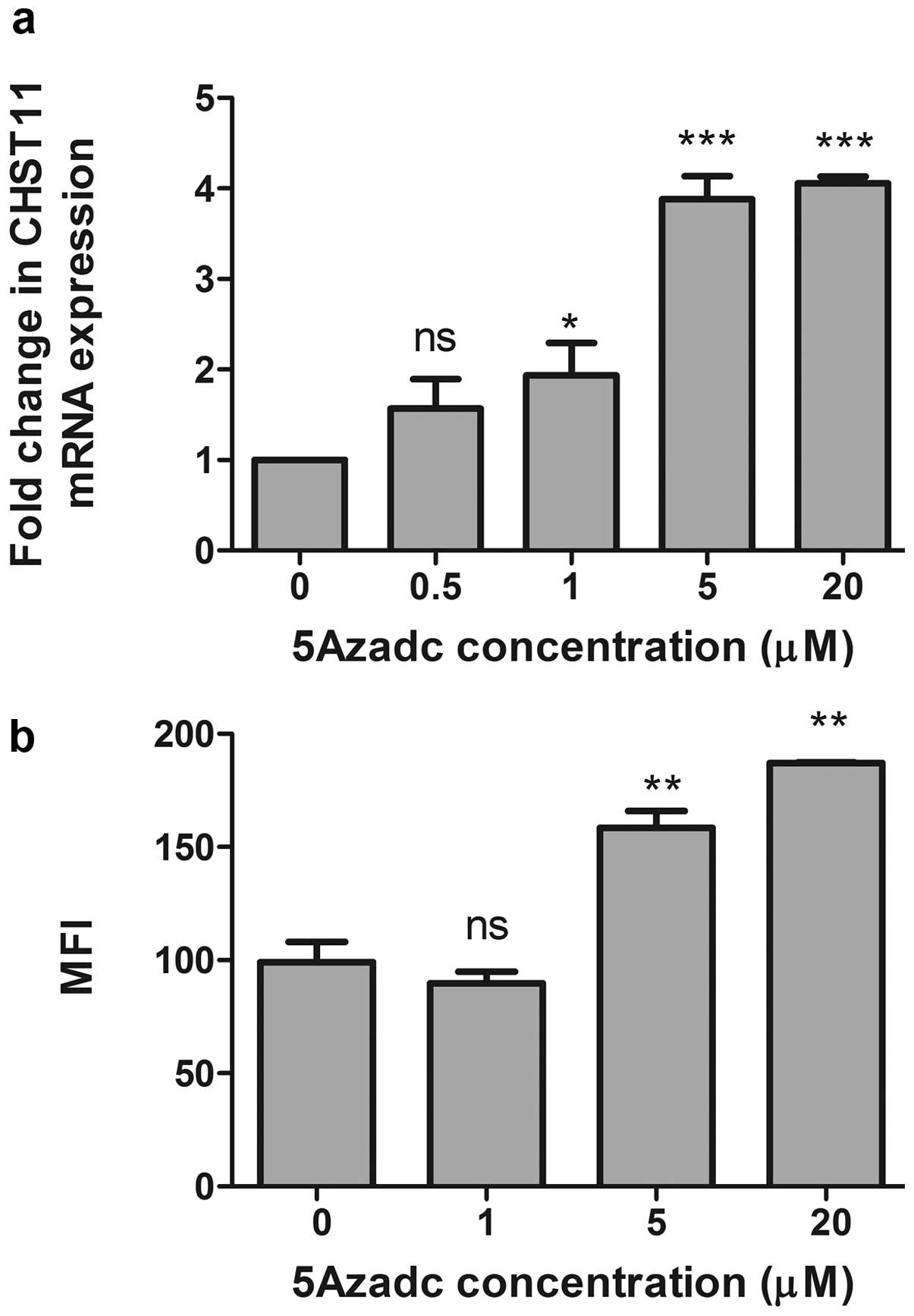|
1
|
Masuda H, Ozeki T, Takazono I and Tanaka
Y: Composition of glycosaminoglycans in human pancreatic cancer.
Biochem Med Metab Biol. 41:193–200. 1989. View Article : Google Scholar : PubMed/NCBI
|
|
2
|
Li F, Ten Dam GB, Murugan S, Yamada S,
Hashiguchi T, Mizumoto S, Oguri K, Okayama M, van Kuppevelt TH and
Sugahara K: Involvement of highly sulfated chondroitin sulfate in
the metastasis of the Lewis lung carcinoma cells. J Biol Chem.
283:34294–34304. 2008. View Article : Google Scholar : PubMed/NCBI
|
|
3
|
Svensson KJ, Christianson HC, Kucharzewska
P, Fagerstrom V, Lundstedt L, Borgquist S, Jirstrom K and Belting
M: Chondroitin sulfate expression predicts poor outcome in breast
cancer. Int J Oncol. 39:1421–1428. 2011.PubMed/NCBI
|
|
4
|
Iida J, Wilhelmson KL, Ng J, Lee P,
Morrison C, Tam E, Overall CM and McCarthy JB: Cell surface
chondroitin sulfate glycosaminoglycan in melanoma: role in the
activation of pro-MMP-2 (pro-gelatinase A). Biochem J. 403:553–563.
2007. View Article : Google Scholar : PubMed/NCBI
|
|
5
|
Monzavi-Karbassi B, Stanley JS, Hennings
L, Jousheghany F, Artaud C, Shaaf S and Kieber-Emmons T:
Chondroitin sulfate glycosaminoglycans as major P-selectin ligands
on metastatic breast cancer cell lines. Int J Cancer.
120:1179–1191. 2007. View Article : Google Scholar
|
|
6
|
Martinez P, Vergoten G, Colomb F, Bobowski
M, Steenackers A, Carpentier M, Allain F, Delannoy P and Julien S:
Over-sulfated glycosaminoglycans are alternative selectin ligands:
insights into molecular interactions and possible role in breast
cancer metastasis. Clin Exp Metastasis. 30:919–931. 2013.
View Article : Google Scholar : PubMed/NCBI
|
|
7
|
Vallen MJ, van der Steen SC, van Tilborg
AA, Massuger LF and van Kuppevelt TH: Sulfated sugars in the
extracellular matrix orchestrate ovarian cancer development: ‘when
sweet turns sour’. Gynecol Oncol. Aug 23–2014.(Epub ahead of
print). pii: S0090-8258(14)01276-1. View Article : Google Scholar
|
|
8
|
Sugahara K, Mikami T, Uyama T, Mizuguchi
S, Nomura K and Kitagawa H: Recent advances in the structural
biology of chondroitin sulfate and dermatan sulfate. Curr Opin
Struct Biol. 13:612–620. 2003. View Article : Google Scholar : PubMed/NCBI
|
|
9
|
Kusche-Gullberg M and Kjellen L:
Sulfotransferases in glycosaminoglycan biosynthesis. Curr Opin
Struct Biol. 13:605–611. 2003. View Article : Google Scholar : PubMed/NCBI
|
|
10
|
Afratis N, Gialeli C, Nikitovic D,
Tsegenidis T, Karousou E, Theocharis AD, Pavao MS, Tzanakakis GN
and Karamanos NK: Glycosaminoglycans: key players in cancer cell
biology and treatment. FEBS J. 279:1177–1197. 2012. View Article : Google Scholar : PubMed/NCBI
|
|
11
|
Mikami T and Kitagawa H: Biosynthesis and
function of chondroitin sulfate. Biochim Biophys Acta.
1830.4719–4733. 2013.
|
|
12
|
Mikami T, Mizumoto S, Kago N, Kitagawa H
and Sugahara K: Specificities of three distinct human
chondroitin/dermatan N-acetylgalactosamine 4-O-sulfotransferases
demonstrated using partially desulfated dermatan sulfate as an
acceptor: implication of differential roles in dermatan sulfate
biosynthesis. J Biol Chem. 278:36115–36127. 2003. View Article : Google Scholar : PubMed/NCBI
|
|
13
|
Uyama T, Ishida M, Izumikawa T, Trybala E,
Tufaro F, Bergstrom T, Sugahara K and Kitagawa H: Chondroitin
4-O-sulfotransferase-1 regulates E disaccharide expression of
chondroitin sulfate required for herpes simplex virus infectivity.
J Biol Chem. 281:38668–38674. 2006. View Article : Google Scholar : PubMed/NCBI
|
|
14
|
Cooney CA, Jousheghany F, Yao-Borengasser
A, Phanavanh B, Gomes T, Kieber-Emmons AM, Siegel ER, Suva LJ,
Ferrone S, Kieber-Emmons T and Monzavi-Karbassi B: Chondroitin
sulfates play a major role in breast cancer metastasis: a role for
CSPG4 and CHST11 gene expression in forming surface P-selectin
ligands in aggressive breast cancer cells. Breast Cancer Res.
13:R582011. View Article : Google Scholar : PubMed/NCBI
|
|
15
|
Kim YJ, Borsig L, Varki NM and Varki A:
P-selectin deficiency attenuates tumor growth and metastasis. Proc
Natl Acad Sci USA. 95:9325–9330. 1998. View Article : Google Scholar : PubMed/NCBI
|
|
16
|
Borsig L, Wong R, Feramisco J, Nadeau DR,
Varki NM and Varki A: Heparin and cancer revisited: mechanistic
connections involving platelets, P-selectin, carcinoma mucins, and
tumor metastasis. Proc Natl Acad Sci USA. 98:3352–3357. 2001.
View Article : Google Scholar : PubMed/NCBI
|
|
17
|
Garcia J, Callewaert N and Borsig L:
P-selectin mediates metastatic progression through binding to
sulfatides on tumor cells. Glycobiology. 17:185–196. 2007.
View Article : Google Scholar
|
|
18
|
Stubke K, Wicklein D, Herich L, Schumacher
U and Nehmann N: Selectin-deficiency reduces the number of
spontaneous metastases in a xenograft model of human breast cancer.
Cancer Lett. 321:89–99. 2012. View Article : Google Scholar : PubMed/NCBI
|
|
19
|
Narayan A, Ji W, Zhang XY, Marrogi A,
Graff JR, Baylin SB and Ehrlich M: Hypomethylation of
pericentromeric DNA in breast adenocarcinomas. Int J Cancer.
77:833–838. 1998. View Article : Google Scholar : PubMed/NCBI
|
|
20
|
Szyf M, Pakneshan P and Rabbani SA: DNA
methylation and breast cancer. Biochem Pharmacol. 68:1187–1197.
2004. View Article : Google Scholar : PubMed/NCBI
|
|
21
|
Ehrlich M: DNA methylation in cancer: too
much, but also too little. Oncogene. 21:5400–5413. 2002. View Article : Google Scholar : PubMed/NCBI
|
|
22
|
Bardowell SA, Parker J, Fan C, Crandell J,
Perou CM and Swift-Scanlan T: Differential methylation relative to
breast cancer subtype and matched normal tissue reveals distinct
patterns. Breast Cancer Res Treat. 142:365–380. 2013. View Article : Google Scholar : PubMed/NCBI
|
|
23
|
Weisenberger DJ: Characterizing DNA
methylation alterations from The Cancer Genome Atlas. J Clin
Invest. 124:17–23. 2014. View Article : Google Scholar : PubMed/NCBI
|
|
24
|
Kalathas D, Triantaphyllidou IE,
Mastronikolis NS, Goumas PD, Papadas TA, Tsiropoulos G and Vynios
DH: The chondroitin/dermatan sulfate synthesizing and modifying
enzymes in laryngeal cancer: expressional and epigenetic studies.
Head Neck Oncol. 2:272010. View Article : Google Scholar : PubMed/NCBI
|
|
25
|
Sun Z, Asmann YW, Kalari KR, Bot B,
Eckel-Passow JE, Baker TR, Carr JM, Khrebtukova I, Luo S, Zhang L,
Schroth GP, Perez EA and Thompson EA: Integrated analysis of gene
expression, CpG island methylation, and gene copy number in breast
cancer cells by deep sequencing. PLoS One. 6:e174902011. View Article : Google Scholar : PubMed/NCBI
|
|
26
|
Richardson AL, Wang ZC, De Nicolo A, Lu X,
Brown M, Miron A, Liao X, Iglehart JD, Livingston DM and Ganesan S:
X chromosomal abnormalities in basal-like human breast cancer.
Cancer Cell. 9:121–132. 2006. View Article : Google Scholar : PubMed/NCBI
|
|
27
|
Finak G, Bertos N, Pepin F, Sadekova S,
Souleimanova M, Zhao H, Chen H, Omeroglu G, Meterissian S, Omeroglu
A, Hallett M and Park M: Stromal gene expression predicts clinical
outcome in breast cancer. Nat Med. 14:518–527. 2008. View Article : Google Scholar : PubMed/NCBI
|
|
28
|
Gluck S, Ross JS, Royce M, McKenna EF Jr,
Perou CM, Avisar E and Wu L: TP53 genomics predict higher clinical
and pathologic tumor response in operable early-stage breast cancer
treated with docetaxel-capecitabine ± trastuzumab. Breast Cancer
Res Treat. 132:781–791. 2012. View Article : Google Scholar
|
|
29
|
Hoeflich KP, O’Brien C, Boyd Z, Cavet G,
Guerrero S, Jung K, Januario T, Savage H, Punnoose E, Truong T,
Zhou W, Berry L, Murray L, Amler L, Belvin M, Friedman LS and
Lackner MR: In vivo antitumor activity of MEK and
phosphatidylinositol 3-kinase inhibitors in basal-like breast
cancer models. Clin Cancer Res. 15:4649–4664. 2009. View Article : Google Scholar : PubMed/NCBI
|
|
30
|
Schuetz CS, Bonin M, Clare SE, Nieselt K,
Sotlar K, Walter M, Fehm T, Solomayer E, Riess O, Wallwiener D,
Kurek R and Neubauer HJ: Progression-specific genes identified by
expression profiling of matched ductal carcinomas in situ and
invasive breast tumors, combining laser capture microdissection and
oligonucleotide microarray analysis. Cancer Res. 66:5278–5286.
2006. View Article : Google Scholar : PubMed/NCBI
|
|
31
|
Rhodes DR, Yu J, Shanker K, Deshpande N,
Varambally R, Ghosh D, Barrette T, Pandey A and Chinnaiyan AM:
ONCOMINE: a cancer microarray database and integrated data-mining
platform. Neoplasia. 6:1–6. 2004. View Article : Google Scholar : PubMed/NCBI
|
|
32
|
Livak KJ and Schmittgen TD: Analysis of
relative gene expression data using real-time quantitative PCR and
the 2(−Delta Delta C(T)) method. Methods. 25:402–408. 2001.
View Article : Google Scholar
|
|
33
|
Leakey TI, Zielinski J, Siegfried RN,
Siegel ER, Fan CY and Cooney CA: A simple algorithm for quantifying
DNA methylation levels on multiple independent CpG sites in
bisulfite genomic sequencing electropherograms. Nucleic Acids Res.
36:e642008. View Article : Google Scholar : PubMed/NCBI
|
|
34
|
Li LC and Dahiya R: MethPrimer: designing
primers for methylation PCRs. Bioinformatics. 18:1427–1431. 2002.
View Article : Google Scholar : PubMed/NCBI
|
|
35
|
Takai D and Jones PA: The CpG island
searcher: a new WWW resource. In Silico Biol. 3:235–240.
2003.PubMed/NCBI
|
|
36
|
Meissner A, Mikkelsen TS, Gu H, Wernig M,
Hanna J, Sivachenko A, Zhang X, Bernstein BE, Nusbaum C, Jaffe DB,
Gnirke A, Jaenisch R and Lander ES: Genome-scale DNA methylation
maps of pluripotent and differentiated cells. Nature. 454:766–770.
2008.PubMed/NCBI
|
|
37
|
Smith ZD, Gu H, Bock C, Gnirke A and
Meissner A: High-throughput bisulfite sequencing in mammalian
genomes. Methods. 48:226–232. 2009. View Article : Google Scholar : PubMed/NCBI
|
|
38
|
Feinberg AP, Gehrke CW, Kuo KC and Ehrlich
M: Reduced genomic 5-methylcytosine content in human colonic
neoplasia. Cancer Res. 48:1159–1161. 1988.PubMed/NCBI
|
|
39
|
Soares J, Pinto AE, Cunha CV, Andre S,
Barao I, Sousa JM and Cravo M: Global DNA hypomethylation in breast
carcinoma: correlation with prognostic factors and tumor
progression. Cancer. 85:112–118. 1999. View Article : Google Scholar : PubMed/NCBI
|
|
40
|
Pakneshan P, Szyf M, Farias-Eisner R and
Rabbani SA: Reversal of the hypomethylation status of urokinase
(uPA) promoter blocks breast cancer growth and metastasis. J Biol
Chem. 279:31735–31744. 2004. View Article : Google Scholar : PubMed/NCBI
|
|
41
|
Chekhun VF, Kulik GI, Yurchenko OV,
Tryndyak VP, Todor IN, Luniv LS, Tregubova NA, Pryzimirska TV,
Montgomery B, Rusetskaya NV and Pogribny IP: Role of DNA
hypomethylation in the development of the resistance to doxorubicin
in human MCF-7 breast adenocarcinoma cells. Cancer Lett. 231:87–93.
2006. View Article : Google Scholar
|
|
42
|
Andrews J, Kennette W, Pilon J, Hodgson A,
Tuck AB, Chambers AF and Rodenhiser DI: Multi-platform whole-genome
microarray analyses refine the epigenetic signature of breast
cancer metastasis with gene expression and copy number. PLoS One.
5:e86652010. View Article : Google Scholar : PubMed/NCBI
|
|
43
|
Wolff EM, Chihara Y, Pan F, Weisenberger
DJ, Siegmund KD, Sugano K, Kawashima K, Laird PW, Jones PA and
Liang G: Unique DNA methylation patterns distinguish noninvasive
and invasive urothelial cancers and establish an epigenetic field
defect in premalignant tissue. Cancer Res. 70:8169–8178. 2010.
View Article : Google Scholar : PubMed/NCBI
|
|
44
|
Kurmasheva RT, Peterson CA, Parham DM,
Chen B, McDonald RE and Cooney CA: Upstream CpG island methylation
of the PAX3 gene in human rhabdomyosarcomas. Pediatr Blood Cancer.
44:328–337. 2005. View Article : Google Scholar
|
|
45
|
Yu Y, Zeng P, Xiong J, Liu Z, Berger SL
and Merlino G: Epigenetic drugs can stimulate metastasis through
enhanced expression of the pro-metastatic Ezrin gene. PLoS One.
5:e127102010. View Article : Google Scholar : PubMed/NCBI
|
|
46
|
Kluppel M, Vallis KA and Wrana JL: A
high-throughput induction gene trap approach defines C4ST as a
target of BMP signaling. Mech Dev. 118:77–89. 2002. View Article : Google Scholar : PubMed/NCBI
|
|
47
|
Willis CM, Wrana JL and Kluppel M:
Identification and characterization of TGFbeta-dependent and
-independent cis-regulatory modules in the C4ST-1/CHST11 locus.
Genet Mol Res. 8:1331–1343. 2009. View Article : Google Scholar : PubMed/NCBI
|
|
48
|
MacLeod AR, Rouleau J and Szyf M:
Regulation of DNA methylation by the Ras signaling pathway. J Biol
Chem. 270:11327–11337. 1995. View Article : Google Scholar : PubMed/NCBI
|
|
49
|
Ramchandani S, MacLeod AR, Pinard M, von
Hofe E and Szyf M: Inhibition of tumorigenesis by a cytosine-DNA,
methyltransferase, antisense oligodeoxynucleotide. Proc Natl Acad
Sci USA. 94:684–689. 1997. View Article : Google Scholar : PubMed/NCBI
|
|
50
|
Fenaux P: Inhibitors of DNA methylation:
beyond myelodysplastic syndromes. Nat Clin Pract Oncol. 2(Suppl 1):
S36–S44. 2005. View Article : Google Scholar : PubMed/NCBI
|
|
51
|
Ateeq B, Unterberger A, Szyf M and Rabbani
SA: Pharmacological inhibition of DNA methylation induces
proinvasive and prometastatic genes in vitro and in vivo.
Neoplasia. 10:266–278. 2008.PubMed/NCBI
|
|
52
|
Meeran SM, Patel SN and Tollefsbol TO:
Sulforaphane causes epigenetic repression of hTERT expression in
human breast cancer cell lines. PLoS One. 5:e114572010. View Article : Google Scholar : PubMed/NCBI
|
|
53
|
Cooney CA: Drugs and supplements that may
slow aging of the epigenome. Drug Discov Today Ther Strateg.
7:57–84. 2010. View Article : Google Scholar
|


















